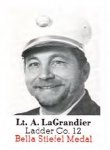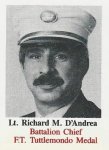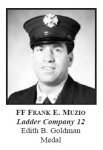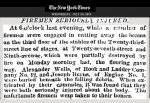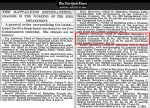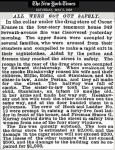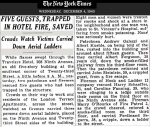You are using an out of date browser. It may not display this or other websites correctly.
You should upgrade or use an alternative browser.
You should upgrade or use an alternative browser.
FDNY and NYC Firehouses and Fire Companies - 2nd Section
- Thread starter mack
- Start date
ENGINE 3/LADDER 12/HIGH RISE 1/BATTALION 7 (CONTINUED)
LADDER 12 MEDAL
FF DANTE R. MAZZETTI LAD. 12 AUG. 9, 2010 2011 TREVOR/WARREN MEDAL

MANHATTAN BOX 22-0596 214 W 21ST STREET
Ladder 12 received a phone alarm for a structural fire at 214 West 21st Street, on August 9, 2010, at 2303 hours. En route, Ladder 12 was informed by the dispatchers that they were receiving multiple calls from the location, a sixstory, non-fireproof building with 30 apartments. On arrival, Lieutenant Jack Bradley, Ladder 12, transmitted the 10-75 for a fire visible from two windows on the fourth floor.
The Lieutenant entered the building with his inside team, which included FF Dante Mazzetti, carrying the extinguisher, and FF Christopher Mallery, the irons Firefighter. Ascending the stairs to the fire floor, they were met by several self-evacuating building occupants who confirmed that a 96-year-old female, Katina Voultespsis, was in the apartment, 3A.
Arriving at the apartment door, the inside team found heavy smoke pushing from around the door frame. FF Mallery positioned himself to force entry, while Lieutenant Bradley and FF
Mazzetti cleared the stairs and public hall of fleeing occupants.
After forcing entry, the crew entered the apartment under high heat and zero visibility. As the team searched deeper into the apartment, the remaining windows in the apartment failed,
intensifying the fire and lighting up the living room. At this point, Battalion Chief Christopher Boyle, Battalion 7, transmitted a second alarm, expecting the fire conditions and auto-exposure to extend the fire to the floor above.
The forcible entry team took refuge in the front bedroom. Knowing a life was at risk, however, they made another attempt toward the living room, still without the protection of a charged hose-line. As FF Mazzetti moved through the apartment in an attempt to locate the fire and control it with his extinguisher, he located the woman in the living room and promptly transmitted the 10-45. FF Mazzetti shielded the woman from the intense heat as Engine 1 members arrived with their hose-line. Lieutenant Robert Narducci, Engine 1, ordered the line to protect the members effecting the removal of Ms. Voultespsis.
In Chief Boyle’s report on the meritorious act, he noted, The actions of FF Mazzetti provided her
only chance for survival. Although she ultimately succumbed to her injuries, FF Mazzetti’s conduct was in the highest traditions of the fire service. In recognition for his heroic efforts under brutal conditions, FF Dante Mazzetti is awarded the Emily Trevor/Mary B. Warren Medal.
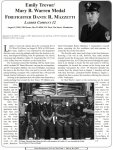
Community Corner
Local Hero Firefighter's Escape Concerts | Coronavirus Latest
Local Hero Firefighter's Online Concerts Are Coronavirus Escape
Even after 24-hour shifts as an NYC firefighter, Dante Mazzetti performs live online concerts from his Chelsea balcony to boost morale.

LADDER 12 MEDAL
FF DANTE R. MAZZETTI LAD. 12 AUG. 9, 2010 2011 TREVOR/WARREN MEDAL

MANHATTAN BOX 22-0596 214 W 21ST STREET
Ladder 12 received a phone alarm for a structural fire at 214 West 21st Street, on August 9, 2010, at 2303 hours. En route, Ladder 12 was informed by the dispatchers that they were receiving multiple calls from the location, a sixstory, non-fireproof building with 30 apartments. On arrival, Lieutenant Jack Bradley, Ladder 12, transmitted the 10-75 for a fire visible from two windows on the fourth floor.
The Lieutenant entered the building with his inside team, which included FF Dante Mazzetti, carrying the extinguisher, and FF Christopher Mallery, the irons Firefighter. Ascending the stairs to the fire floor, they were met by several self-evacuating building occupants who confirmed that a 96-year-old female, Katina Voultespsis, was in the apartment, 3A.
Arriving at the apartment door, the inside team found heavy smoke pushing from around the door frame. FF Mallery positioned himself to force entry, while Lieutenant Bradley and FF
Mazzetti cleared the stairs and public hall of fleeing occupants.
After forcing entry, the crew entered the apartment under high heat and zero visibility. As the team searched deeper into the apartment, the remaining windows in the apartment failed,
intensifying the fire and lighting up the living room. At this point, Battalion Chief Christopher Boyle, Battalion 7, transmitted a second alarm, expecting the fire conditions and auto-exposure to extend the fire to the floor above.
The forcible entry team took refuge in the front bedroom. Knowing a life was at risk, however, they made another attempt toward the living room, still without the protection of a charged hose-line. As FF Mazzetti moved through the apartment in an attempt to locate the fire and control it with his extinguisher, he located the woman in the living room and promptly transmitted the 10-45. FF Mazzetti shielded the woman from the intense heat as Engine 1 members arrived with their hose-line. Lieutenant Robert Narducci, Engine 1, ordered the line to protect the members effecting the removal of Ms. Voultespsis.
In Chief Boyle’s report on the meritorious act, he noted, The actions of FF Mazzetti provided her
only chance for survival. Although she ultimately succumbed to her injuries, FF Mazzetti’s conduct was in the highest traditions of the fire service. In recognition for his heroic efforts under brutal conditions, FF Dante Mazzetti is awarded the Emily Trevor/Mary B. Warren Medal.

Community Corner
Local Hero Firefighter's Escape Concerts | Coronavirus Latest
Local Hero Firefighter's Online Concerts Are Coronavirus Escape
Even after 24-hour shifts as an NYC firefighter, Dante Mazzetti performs live online concerts from his Chelsea balcony to boost morale.

ENGINE 3/LADDER 12/HIGH RISE 1/BATTALION 7 (CONTINUED)
LADDER 12 LODD
FF EDWARD DUNN, LAD. 12 NOVEMBER 3, 1894
Fireman Edward Dunn of Hook & Ladder 12 fell from the truck in front of 75 Eighth Avenue at 9:30 o’clock in the evening and was killed. The truck was on the way to a fire at 301 West 13th Street. Dunn tried to jump on the sideboard, missed the handles and fell under the wheels, which passed over his body. He was thirty-four years old, and lived with his father at 314 East 66th Street. - from "The Last Alarm"
RIP. NEVER FORGET.
LADDER 12 LODD
FF EDWARD DUNN, LAD. 12 NOVEMBER 3, 1894
Fireman Edward Dunn of Hook & Ladder 12 fell from the truck in front of 75 Eighth Avenue at 9:30 o’clock in the evening and was killed. The truck was on the way to a fire at 301 West 13th Street. Dunn tried to jump on the sideboard, missed the handles and fell under the wheels, which passed over his body. He was thirty-four years old, and lived with his father at 314 East 66th Street. - from "The Last Alarm"
RIP. NEVER FORGET.
ENGINE 3/LADDER 12/HIGH RISE 1/BATTALION 7 (CONTINUED)
LADDER 12 LODD
LT JOHN L. ROONEY, LAD. 12 DECEMBER 29, 1894
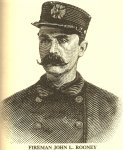
LT Rooney was killed with BC John J. Bresnan at a 3rd alarm in a loft building on W. 24th Street when a 3,000 gallon water tank collapsed and crashed through the fire building.

FIRE BUILDING 124 W 24TH STREET
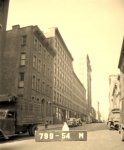
FF ROONEY JAMES GORDON BENNETT MEDEAL 1882

Paul Hashagen- author
October 9, 2017
From the Vault:
This is the oldest known illustration of an FDNY medal presentation. On May 16, 1883 in Union Square Plaza Mayor Franklin Edson awards the James Gordon Bennett Medal to John L. Rooney.
Then the name “Fireman John L. Rooney” echoed across the plaza and the crowd began cheering as the firemen stepped from the ranks and took a position before the dignitaries.
The story of Rooney’s rescue was read to the crowd. His rescue of Miss Ida Small on January 31, 1882 took place during the fire in the Potter Building (also known as the World Building after the old newspaper). Members of Hook & Ladder 10, second due, arrived to find flames racing upwards in a newly installed elevator shaft. Faced with extending fire, numerous people trapped and near blizzard conditions Battalion Chief Mahedy transmitted a third alarm upon his arrival moments before.
Miss Small appeared standing in a fifth floor window with heavy smoke billowing around her. A ladder was pushed through the building crowds of people watching the blazing spectacle. The ladder was carefully raised amongst the overhead telegraph wires and lowered into the building. Fireman John Rooney began climbing the ladder bending beneath each step. Reaching the top he realized the woman was still beyond his reach.
Seeing the ladder’s reach was short the firemen on the ground called to the crowd for help. Their numbers now swelled with additional firemen and civilian volunteers. Firemen called up to Rooney to hold on. He wrapped his arms and legs around the ladder and called back he was ready.
The men on the ground raised the ladder perpendicular. On a command they began to lift it off the sidewalk. They continued to raise it, fireman and all, until it was held at arms length above their heads. With snow nearing their knees and blowing up around them, they held the ladder steady as Rooney unfolded himself. He directed her to sit on the sill and to hold onto his shoulders. He gripped her by the waist and told her to drop into his arms. With the ladder swaying beneath him the lady was taken from the brink of eternity. The crowds cheered as Rooney carried Miss Small to the street.
For his bravery Rooney received the Bennett Medal and was promoted to Lieutenant. Sadly John Rooney and Battalion Chief John J. Bresnan were both killed in a building collapse on Dec. 29, 1894
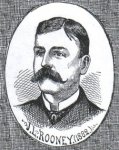
LT ROONEY FUNERAL

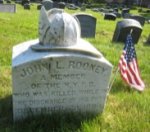
LODD BC JOHN J BRESNAN BATT 6 DECEMBER 29, 1894
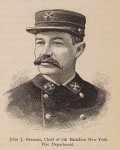
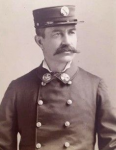
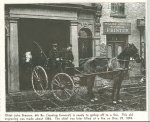
BC Bresnan was a Civil War veteran who served in the 69th Regiment
https://dmna.ny.gov/historic/btlflags/infantry/69thInfRegColor2013.0022.htm
RIP. NEVER FORGET.
LADDER 12 LODD
LT JOHN L. ROONEY, LAD. 12 DECEMBER 29, 1894

LT Rooney was killed with BC John J. Bresnan at a 3rd alarm in a loft building on W. 24th Street when a 3,000 gallon water tank collapsed and crashed through the fire building.

FIRE BUILDING 124 W 24TH STREET

FF ROONEY JAMES GORDON BENNETT MEDEAL 1882

Paul Hashagen- author
October 9, 2017
From the Vault:
This is the oldest known illustration of an FDNY medal presentation. On May 16, 1883 in Union Square Plaza Mayor Franklin Edson awards the James Gordon Bennett Medal to John L. Rooney.
Then the name “Fireman John L. Rooney” echoed across the plaza and the crowd began cheering as the firemen stepped from the ranks and took a position before the dignitaries.
The story of Rooney’s rescue was read to the crowd. His rescue of Miss Ida Small on January 31, 1882 took place during the fire in the Potter Building (also known as the World Building after the old newspaper). Members of Hook & Ladder 10, second due, arrived to find flames racing upwards in a newly installed elevator shaft. Faced with extending fire, numerous people trapped and near blizzard conditions Battalion Chief Mahedy transmitted a third alarm upon his arrival moments before.
Miss Small appeared standing in a fifth floor window with heavy smoke billowing around her. A ladder was pushed through the building crowds of people watching the blazing spectacle. The ladder was carefully raised amongst the overhead telegraph wires and lowered into the building. Fireman John Rooney began climbing the ladder bending beneath each step. Reaching the top he realized the woman was still beyond his reach.
Seeing the ladder’s reach was short the firemen on the ground called to the crowd for help. Their numbers now swelled with additional firemen and civilian volunteers. Firemen called up to Rooney to hold on. He wrapped his arms and legs around the ladder and called back he was ready.
The men on the ground raised the ladder perpendicular. On a command they began to lift it off the sidewalk. They continued to raise it, fireman and all, until it was held at arms length above their heads. With snow nearing their knees and blowing up around them, they held the ladder steady as Rooney unfolded himself. He directed her to sit on the sill and to hold onto his shoulders. He gripped her by the waist and told her to drop into his arms. With the ladder swaying beneath him the lady was taken from the brink of eternity. The crowds cheered as Rooney carried Miss Small to the street.
For his bravery Rooney received the Bennett Medal and was promoted to Lieutenant. Sadly John Rooney and Battalion Chief John J. Bresnan were both killed in a building collapse on Dec. 29, 1894

LT ROONEY FUNERAL


LODD BC JOHN J BRESNAN BATT 6 DECEMBER 29, 1894



BC Bresnan was a Civil War veteran who served in the 69th Regiment
https://dmna.ny.gov/historic/btlflags/infantry/69thInfRegColor2013.0022.htm
RIP. NEVER FORGET.
Last edited:
ENGINE 3/LADDER 12/HIGH RISE 1/BATTALION 7 (CONTINUED)
ENGINE 3 LODD
FF JAMES W. GERDES, ENG. 3 JUNE 1, 1904
The death of Joseph W. Gerdes, a Fireman of the fourth grade, attached to Engine 3, 417 West 17th Street occurred in the New York Hospital and was made a matter of investigation by Fire Commissioner Hayes.
Assistant Foreman Carlock, commanding the company in the absence of the Foreman, ordered a test of the fire hose during which Gerdes was injured. Commissioner Hayes received Assistant Foreman Carlock’s report of the accident. In it, Carlock said that Gerdes was engaged with Firemen Dougherty and Lenahan testing some new hose in front of the engine house. Dougherty and Lenahan were at the nozzle. The pressure was turned on gradually until 180 pounds had been reached, when the hose burst, and the nozzle was wrenched from Dougherty and Lenahan. The nozzle, in flying backward, struck Gerdes, knocking him against the front wheel of the fire engine. Four front teeth were knocked out, his upper lip badly cut, and he was rendered unconscious.
At New York Hospital, death resulted from cerebral hemorrhage.
- from "The Last Alarm"
RIP. NEVER FORGET.
ENGINE 3 LODD
FF JAMES W. GERDES, ENG. 3 JUNE 1, 1904
The death of Joseph W. Gerdes, a Fireman of the fourth grade, attached to Engine 3, 417 West 17th Street occurred in the New York Hospital and was made a matter of investigation by Fire Commissioner Hayes.
Assistant Foreman Carlock, commanding the company in the absence of the Foreman, ordered a test of the fire hose during which Gerdes was injured. Commissioner Hayes received Assistant Foreman Carlock’s report of the accident. In it, Carlock said that Gerdes was engaged with Firemen Dougherty and Lenahan testing some new hose in front of the engine house. Dougherty and Lenahan were at the nozzle. The pressure was turned on gradually until 180 pounds had been reached, when the hose burst, and the nozzle was wrenched from Dougherty and Lenahan. The nozzle, in flying backward, struck Gerdes, knocking him against the front wheel of the fire engine. Four front teeth were knocked out, his upper lip badly cut, and he was rendered unconscious.
At New York Hospital, death resulted from cerebral hemorrhage.
- from "The Last Alarm"
RIP. NEVER FORGET.
ENGINE 3/LADDER 12/HIGH RISE 1/BATTALION 7 (CONTINUED)
LADDER 12 LODD
BC WALTER J. HIGGINS, BN. 7 OCTOBER 17, 1966 - 23RD STREET FIRE
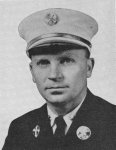
BC Higgins made the Supreme Sacrifice at the 23rd Street Fire.
On October 17, 1966 what started out as a small odor of smoke turned into a five-alarm inferno that claimed the lives of twelve firemen. At 9:36 p.m., Engine Companies 14, 3, 16, Ladder Companies 3, 12, and Battalion 6 responded to Box 598 for a report of smoke at 7 East 22nd Street. Engine 14, the first to arrive in front of the building, saw nothing.
Checking with the calling party they found a basement fire in the rear of the building in a one-story extension. Unable to locate the fire, the companies were driven out by an intense build-up of heat and smoke. Ladder 7 was special called and operated for a time on 22nd Street before being ordered to check the 6 23rd Street which was the rear of 7 East 22nd Street. Shortly after, a second alarm was transmitted and Engine 18 responded to the fire. They hooked up to a hydrant on East 23rd Street near the Wonder Drug Store which was now issuing some smoke. Most of the operations were still on East 22nd Street.
Deputy Chief Thomas A. Reilly of Division 3 along with his Aide William F. McCarron ordered the members of Ladder 7 and Engine 18 into the drug store to look for extension of the fire. Lieutenant John J. Finley of Ladder 7 split his crew into two parts with two members going upstairs to the second floor while he and Firemen John G. Berry, Carl Lee, and Rudolph F. Kaminsky went to the first floor to find the seat of the fire. The crews from Engines 18 and 33 were with Chief Reilly. He ordered Engine 33, standing the closest to Broadway, to stretch a hose line into one of the buildings on Broadway. Engine 18 was ordered to take their hose line into Wonder Drug. Lieutenant Joseph Prior, detailed to Engine 18 for the night tour from Battalion 4, along with Firemen Bernard A. Tepper, Joseph Kelly #2, James V. Galanaugh, and Probationary Fireman, Daniel L. Rey, entered the drug store with a hose line from Engine 5. These two companies were under the command of Battalion Chief Walter J. Higgins of Battalion 7.
Engine 3 and Engine 5 were ordered into the basement of the drug store. Deputy Chief Reilly went to the roof to check the conditions from that perspective. He found that the fire had extended from East 22nd Street to the corner building on the Broadway side of the fire. He returned to the first floor of the drug store to see what progress had been made since he left. He found Ladder 7 and Engine 18 in the rear of the drug store.
At 10:39 without any warning the rear section of the drug store was swallowed up and the first floor collapsed into the fiery hell of the basement. The twelve brave men in the rear of the store were consumed by the “Red Devil”. The members of Ladder 3 and Engine 5 were all injured in the collapse, but not trapped, and made their way to safety. The fire had originated in the basement of the drug store and had been burning for a long time.
-from "The Last Alarm
https://www.flickr.com/photos/fdnyhome/sets/72157675107113676
HELMET BC HIGGINS
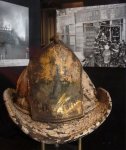
US NAVY - WORLD WAR II SERVICE
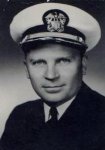
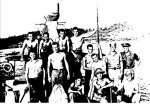
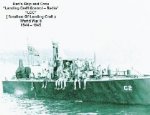
RIP. NEVER FORGET.
LADDER 12 LODD
BC WALTER J. HIGGINS, BN. 7 OCTOBER 17, 1966 - 23RD STREET FIRE

BC Higgins made the Supreme Sacrifice at the 23rd Street Fire.
On October 17, 1966 what started out as a small odor of smoke turned into a five-alarm inferno that claimed the lives of twelve firemen. At 9:36 p.m., Engine Companies 14, 3, 16, Ladder Companies 3, 12, and Battalion 6 responded to Box 598 for a report of smoke at 7 East 22nd Street. Engine 14, the first to arrive in front of the building, saw nothing.
Checking with the calling party they found a basement fire in the rear of the building in a one-story extension. Unable to locate the fire, the companies were driven out by an intense build-up of heat and smoke. Ladder 7 was special called and operated for a time on 22nd Street before being ordered to check the 6 23rd Street which was the rear of 7 East 22nd Street. Shortly after, a second alarm was transmitted and Engine 18 responded to the fire. They hooked up to a hydrant on East 23rd Street near the Wonder Drug Store which was now issuing some smoke. Most of the operations were still on East 22nd Street.
Deputy Chief Thomas A. Reilly of Division 3 along with his Aide William F. McCarron ordered the members of Ladder 7 and Engine 18 into the drug store to look for extension of the fire. Lieutenant John J. Finley of Ladder 7 split his crew into two parts with two members going upstairs to the second floor while he and Firemen John G. Berry, Carl Lee, and Rudolph F. Kaminsky went to the first floor to find the seat of the fire. The crews from Engines 18 and 33 were with Chief Reilly. He ordered Engine 33, standing the closest to Broadway, to stretch a hose line into one of the buildings on Broadway. Engine 18 was ordered to take their hose line into Wonder Drug. Lieutenant Joseph Prior, detailed to Engine 18 for the night tour from Battalion 4, along with Firemen Bernard A. Tepper, Joseph Kelly #2, James V. Galanaugh, and Probationary Fireman, Daniel L. Rey, entered the drug store with a hose line from Engine 5. These two companies were under the command of Battalion Chief Walter J. Higgins of Battalion 7.
Engine 3 and Engine 5 were ordered into the basement of the drug store. Deputy Chief Reilly went to the roof to check the conditions from that perspective. He found that the fire had extended from East 22nd Street to the corner building on the Broadway side of the fire. He returned to the first floor of the drug store to see what progress had been made since he left. He found Ladder 7 and Engine 18 in the rear of the drug store.
At 10:39 without any warning the rear section of the drug store was swallowed up and the first floor collapsed into the fiery hell of the basement. The twelve brave men in the rear of the store were consumed by the “Red Devil”. The members of Ladder 3 and Engine 5 were all injured in the collapse, but not trapped, and made their way to safety. The fire had originated in the basement of the drug store and had been burning for a long time.
-from "The Last Alarm
https://www.flickr.com/photos/fdnyhome/sets/72157675107113676
HELMET BC HIGGINS

US NAVY - WORLD WAR II SERVICE



RIP. NEVER FORGET.
Last edited:
ENGINE 3/LADDER 12/HIGH RISE 1/BATTALION 7 (CONTINUED)
ENGINE 3 LODD
LT FRANK J. BRENNAN, ENG. 3 SEPTEMBER 6, 1973
Lieutenant Frank J. Brennan, Engine Company 3, suffered a stroke while operating at a fire at Seventh Avenue and West 12th Street in Manhattan - Box 528 - on June 3, 1973. He was taken to St. Vincent’s Hospital. He sustained a second, fatal stroke three months later.
Lieutenant Frank J. Brennan, Engine 3, was a 19-year veteran.
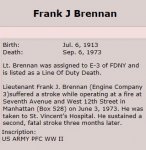

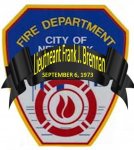
RIP. NEVER FORGET.
ENGINE 3 LODD
LT FRANK J. BRENNAN, ENG. 3 SEPTEMBER 6, 1973
Lieutenant Frank J. Brennan, Engine Company 3, suffered a stroke while operating at a fire at Seventh Avenue and West 12th Street in Manhattan - Box 528 - on June 3, 1973. He was taken to St. Vincent’s Hospital. He sustained a second, fatal stroke three months later.
Lieutenant Frank J. Brennan, Engine 3, was a 19-year veteran.



RIP. NEVER FORGET.
Last edited:
ENGINE 3/LADDER 12/HIGH RISE 1/BATTALION 7 (CONTINUED)
LADDER 12 LODD
FF ANGEL JUARBE, JR, LAD. 12 SEPTEMBER 11, 2001
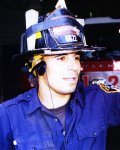

Fire Hero Family Programs
Fire Service Programs
ROLL OF HONOR
Angel L. Juarbe
Firefighter
Fire Department City of New York
New York
Age: 35
Year of Death: 2001
Angel L. Juarbe Jr.‚ 35‚ firefighter‚ FDNY‚ Ladder 12. A 7-year FDNY veteran‚ Juarbe was chosen as one of 12 firemen to be in the ‘Firehouse Hunks 2002’ calendar. Just a week before the September 11 tragedy‚ he was the winner of a Fox network reality show‚ Murder in Small Town X‚ in which the contestants vied to solve a fake murder. Juarbe won a Jeep and $250‚000. An animal lover‚ Juarbe had turned the firehouse into a place neighborhood kids could hang out but only after they had completed their homework.
https://www.firehero.org/fallen-firefighter/angel-l-juarbe/
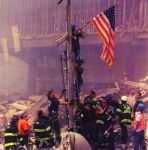
Up-110
May 6 ·
FDNY firefighter Angel Juarbe, Jr. of Ladder 12 was born on May 1, 1966. A Bronx native, Juarbe had been working at Ladder 12 for eight years and had just finished his shift when the Sept. 11 call came in. Once they reported to the WTC, Juarbe and his colleagues were sent to search and evacuate the Marriott Hotel from the 14th floor up. When they hit the 19th floor, the South Tower fell causing complete catastrophe and a bomb-like aftermath. The team realized they needed to get out fast. They dropped all of their equipment and tools so that they could evacuate the building faster. They made it down to the 4th floor where they ran out of stairs. Part of the stairwell had collapsed. The stranded rescuers quickly realized they would need their tools after all. The only way out was to rappel down the ravaged stairwell using roof rope. Someone would have to go up and retrieve it. Angel and a Lieutenant in his company were quick to volunteer.
As the two brave men began the long trek back up the stories of the hotel, they came into contact with another firefighter who was in trouble. Angel radioed back to the stranded men on the 4th floor that there was a firefighter who needed assistance. At this point, the unimaginable happened. The World Trade Center's north tower collapsed. This was at 10:28 AM.
Amazingly, the firefighters stranded in the 4th floor stairwell all survived. Angel Juarbe and the two other rescuers from Ladder 12 did not.
Less notably, Juarbe was the winner of the Fox television reality competition, Murder In Small Town X. They announced him the winner on September 4th, and exactly one week later he was killed.
He and his family hugged and cried when they received the news. He promised to throw a block party, where he was going to announce that he would use part of the money for a scholarship fund for his nephews and nieces. There, Juarbe would also hand the keys to the sport utility vehicle to his father, Angel Sr., and would give his mother, Miriam, the down payment for the family's first home.
Shared from never forget 1st responders
ANGEL JUARBE

World Trade Center
A PINUP AND A SLEUTH
The sun seemed to shine on Angel Juarbe, a firefighter with Ladder 12 in Chelsea. He was an animal lover, with eight formerly stray dogs, who visited Tanzania to see lions and zebras, then left just two days before the bombing of the United States Embassy in 1998. Single and handsome, he was one of 12 New York firefighters chosen to pose for the calendar "Firehouse Hunks 2002."
A week before the Sept. 11 tragedy, Mr. Juarbe, 35, was the winner in an eight-part game show on the Fox network in which 10 contestants, chosen from 3,000 applicants, competed to solve a fake murder. The show was called "Murder in Small Town X," and Mr. Juarbe tracked down the killer. He won a Jeep and $250,000.
He kept the secret from his family until Sept. 4, when the final show was broadcast. After the terror attacks, the show's entire cast visited his family. His mother, Miriam, recalled what his friends said. "If only I could live one day of your life, even an hour." She added, "Most of them are married, you know."
Profile published in THE NEW YORK TIMES on October 11, 2001.
http://www.legacy.com/sept11/story.aspx?personid=139442
Bracelets For America Remembers
Remembering the Heroes of Sept. 11 each and every day. We Will Never Forget!
Sunday, October 17, 2010
Today We Remember FF Angel Juarbe Jr.
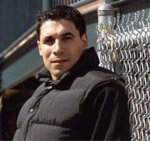
Today we remember Angel Juarbe Jr., Ladder Co. 12, FDNY.
A Bronx native, Juarbe had been working at Ladder 12 for eight years and had just finished his shift when the Sept. 11 call came in. Once they reported to the WTC, Juarbe and his colleagues were sent to search and evacuate the Marriott Hotel from the 14th floor up. When they hit the 19th floor, the South Tower fell causing complete catastrophe and a bomb-like aftermath. The team realized they needed to get out fast. They dropped all of their equipment and tools so that they could evacuate the building faster. They made it down to the 4th floor where they ran out of stairs. Part of the stairwell had collapsed. The stranded rescuers quickly realized they would need their tools after all. The only way out was to rappel down the ravaged stairwell using roof rope. Someone would have to go up and retrieve it. Angel and a Lieutenant in his company were quick to volunteer.
As the two brave men began the long trek back up the stories of the hotel, they came into contact with another firefighter who was in trouble. Angel radioed back to the stranded men on the 4th floor that there was a firefighter who needed assistance. At this point, the unimaginable happened. The World Trade Center's north tower collapsed. This was at 10:28 AM. Amazingly, the firefighters stranded in the 4th floor stairwell all survived. Angel Juarbe and the two other rescuers from Ladder 12 did not.
Less notably, Juarbe was the winner of the Fox television reality competition, Murder In Small Town X. They announced him the winner on September 4th, and exactly one week later he was killed.
He and his family hugged and cried when they received the news. He promised to throw a block party, where he was going to announce that he would use part of the money for a scholarship fund for his nephews and nieces. There, Juarbe would also hand the keys to the sport utility vehicle to his father, Angel Sr., and would give his mother, Miriam, the down payment for the family's first home.
We Will Never Forget!
http://todayremember.blogspot.com/2010/10/today-we-remember-ff-angel-juarbe-jr.html



LADDER 12 LODD
FF ANGEL JUARBE, JR, LAD. 12 SEPTEMBER 11, 2001

Fire Hero Family Programs
Fire Service Programs
ROLL OF HONOR
Angel L. Juarbe
Firefighter
Fire Department City of New York
New York
Age: 35
Year of Death: 2001
Angel L. Juarbe Jr.‚ 35‚ firefighter‚ FDNY‚ Ladder 12. A 7-year FDNY veteran‚ Juarbe was chosen as one of 12 firemen to be in the ‘Firehouse Hunks 2002’ calendar. Just a week before the September 11 tragedy‚ he was the winner of a Fox network reality show‚ Murder in Small Town X‚ in which the contestants vied to solve a fake murder. Juarbe won a Jeep and $250‚000. An animal lover‚ Juarbe had turned the firehouse into a place neighborhood kids could hang out but only after they had completed their homework.
https://www.firehero.org/fallen-firefighter/angel-l-juarbe/

Up-110
May 6 ·
FDNY firefighter Angel Juarbe, Jr. of Ladder 12 was born on May 1, 1966. A Bronx native, Juarbe had been working at Ladder 12 for eight years and had just finished his shift when the Sept. 11 call came in. Once they reported to the WTC, Juarbe and his colleagues were sent to search and evacuate the Marriott Hotel from the 14th floor up. When they hit the 19th floor, the South Tower fell causing complete catastrophe and a bomb-like aftermath. The team realized they needed to get out fast. They dropped all of their equipment and tools so that they could evacuate the building faster. They made it down to the 4th floor where they ran out of stairs. Part of the stairwell had collapsed. The stranded rescuers quickly realized they would need their tools after all. The only way out was to rappel down the ravaged stairwell using roof rope. Someone would have to go up and retrieve it. Angel and a Lieutenant in his company were quick to volunteer.
As the two brave men began the long trek back up the stories of the hotel, they came into contact with another firefighter who was in trouble. Angel radioed back to the stranded men on the 4th floor that there was a firefighter who needed assistance. At this point, the unimaginable happened. The World Trade Center's north tower collapsed. This was at 10:28 AM.
Amazingly, the firefighters stranded in the 4th floor stairwell all survived. Angel Juarbe and the two other rescuers from Ladder 12 did not.
Less notably, Juarbe was the winner of the Fox television reality competition, Murder In Small Town X. They announced him the winner on September 4th, and exactly one week later he was killed.
He and his family hugged and cried when they received the news. He promised to throw a block party, where he was going to announce that he would use part of the money for a scholarship fund for his nephews and nieces. There, Juarbe would also hand the keys to the sport utility vehicle to his father, Angel Sr., and would give his mother, Miriam, the down payment for the family's first home.
Shared from never forget 1st responders
ANGEL JUARBE

World Trade Center
A PINUP AND A SLEUTH
The sun seemed to shine on Angel Juarbe, a firefighter with Ladder 12 in Chelsea. He was an animal lover, with eight formerly stray dogs, who visited Tanzania to see lions and zebras, then left just two days before the bombing of the United States Embassy in 1998. Single and handsome, he was one of 12 New York firefighters chosen to pose for the calendar "Firehouse Hunks 2002."
A week before the Sept. 11 tragedy, Mr. Juarbe, 35, was the winner in an eight-part game show on the Fox network in which 10 contestants, chosen from 3,000 applicants, competed to solve a fake murder. The show was called "Murder in Small Town X," and Mr. Juarbe tracked down the killer. He won a Jeep and $250,000.
He kept the secret from his family until Sept. 4, when the final show was broadcast. After the terror attacks, the show's entire cast visited his family. His mother, Miriam, recalled what his friends said. "If only I could live one day of your life, even an hour." She added, "Most of them are married, you know."
Profile published in THE NEW YORK TIMES on October 11, 2001.
http://www.legacy.com/sept11/story.aspx?personid=139442
Bracelets For America Remembers
Remembering the Heroes of Sept. 11 each and every day. We Will Never Forget!
Sunday, October 17, 2010
Today We Remember FF Angel Juarbe Jr.

Today we remember Angel Juarbe Jr., Ladder Co. 12, FDNY.
A Bronx native, Juarbe had been working at Ladder 12 for eight years and had just finished his shift when the Sept. 11 call came in. Once they reported to the WTC, Juarbe and his colleagues were sent to search and evacuate the Marriott Hotel from the 14th floor up. When they hit the 19th floor, the South Tower fell causing complete catastrophe and a bomb-like aftermath. The team realized they needed to get out fast. They dropped all of their equipment and tools so that they could evacuate the building faster. They made it down to the 4th floor where they ran out of stairs. Part of the stairwell had collapsed. The stranded rescuers quickly realized they would need their tools after all. The only way out was to rappel down the ravaged stairwell using roof rope. Someone would have to go up and retrieve it. Angel and a Lieutenant in his company were quick to volunteer.
As the two brave men began the long trek back up the stories of the hotel, they came into contact with another firefighter who was in trouble. Angel radioed back to the stranded men on the 4th floor that there was a firefighter who needed assistance. At this point, the unimaginable happened. The World Trade Center's north tower collapsed. This was at 10:28 AM. Amazingly, the firefighters stranded in the 4th floor stairwell all survived. Angel Juarbe and the two other rescuers from Ladder 12 did not.
Less notably, Juarbe was the winner of the Fox television reality competition, Murder In Small Town X. They announced him the winner on September 4th, and exactly one week later he was killed.
He and his family hugged and cried when they received the news. He promised to throw a block party, where he was going to announce that he would use part of the money for a scholarship fund for his nephews and nieces. There, Juarbe would also hand the keys to the sport utility vehicle to his father, Angel Sr., and would give his mother, Miriam, the down payment for the family's first home.
We Will Never Forget!
http://todayremember.blogspot.com/2010/10/today-we-remember-ff-angel-juarbe-jr.html



Last edited:
- Joined
- May 6, 2010
- Messages
- 17,436
^^^ In regard to post # 2733 ..Continued Rest In Peace to LT Brennan ENG*3 ....LT Brennan's Son Jim was a FF Appt to 108 on Siegel St in the next proby class after me in '68 & is still a good friend...when his Dad a LT in ENG*3 died in '73 we all went to the Funeral then to the coalition at the Knights of Columbus on Quentin & Nostrand Aves in BKLN.....afterward several of us were leaving the K of C returning to the FH as some had to work the Night tour & some were going to the UFA meeting that evening...I was driving my '70 Plymouth Road Runner back & forth from the Services with other guys in my full car so now as I am driving up Bedford Ave as we pass the old Ebbit's Field site I say "any old BKLYN Dodger fans that want to give a salute to the Dodgers do it now".... out of the corner of my eye I see one of our LT's who was sitting on the right of me raising his arm...I am thinking to myself "how cute ...I never knew he was a Dodger fan" but he was raising his hand to try & hold in his projectile puke which spewed out full force...we get back to the FH around the change of tours & I double park & everybody goes inside ....those working change to their work duty uniforms & us going to the Union Meeting change into civilian clothes....Pete L. says he is driving to Manh. for the Meeting ...I leave my keys in the House Watch so someone on the Night tour can move my double parked Roadrunner into a spot after the Day tour guys leave .....my car sat with the windows closed sitting in the hot weather & remaining sunlight with the puke on the floor & then became extremely ripe... the poor FF who got into my car to move it later almost puked himself.
Last edited:
ENGINE 3/LADDER 12/HIGH RISE 1/BATTALION 7 (CONTINUED)
LADDER 12 LODD
FF MICHAEL MULLAN, LAD. 12 SEPTEMBER 11, 2001 WTC
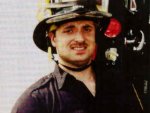
Firefighter Michael Mullan
Ladder 12
Laid to Rest
on October 20, 2001
Firefighter Michael Mullan
Michael Dermott Mullan 'Full of Devilment,' He Lived Every Day October 5, 2001 Michael Mullan, 34, was born and reared in Flushing, where he graduated from Holy Cross High School and attended Queensboro Community College. At the time of the World Trade Center attacks, Mullan was studying for a bachelor's degree in nursing at Hunter College. He was on the 19th floor when he and other firefighters received orders to evacuate, because "the building was starting to go," according to his mother, Theresa. Mullan and two other firefighters headed down but stopped at the third floor, where they heard a Mayday call from two firefighters higher up. "Michael said, 'I'll go get them,'" his mother said - and that was the last anyone heard of him. A registered nurse, Mullan also worked in the Mercy Hospital emergency room on a per diem basis. He was a captain in the U.S. Army Reserve and worked for Ladder 12, Engine Co. 3 in Chelsea. He was "just about" engaged to his girlfriend, his mother said. She continued: "There's an old Irish expression: May you live every day of your life. Michael lived every day of his life." An avid Yankees fan, "he took it as a personal insult if they lost. He loved plays and concerts, and, oh, when he played the piano, you could not tell the difference between Michael Mullan and Jerry Lee Lewis. When he got up, the piano went into cardiac arrest. And he loved Elvis! He kept saying to me, 'Mom, you must have had a great time in the '50s.' And let me tell you, he was full of devilment and merriment and mischief." After the attack, she visited Blessed Sacrament, his grammar school, to ask for the children's prayers. "And when I walked into the principal's office, I said, 'Do you know, this is the first time I have walked into this office that I did not get sent for?'" Devilment aside, Theresa Mullan said, "Michael always made you laugh." He is also survived by his father, Patrick; brother, Patrick, and sister, Kelly-Ann Mary. "And don't forget," his mother said, "It's 'Mullan' with an 'a.'" --Mary Voboril (Newsday)
http://bravestmemorial.net/html/members/mullan_michael_fr_l012.html
Firefighter Mike Mullan of Ladder 12 was also a Captain in the Army Reserve and an R.N. who worked in the ER at Mercy Hospital, with longer term plans to become a nurse practitioner. “He played the piano like Jerry Lee Lewis,” his mother said, “and when he got up, the piano went into cardiac arrest.
http://betterangels911.com/firefighter-michael-mullan/
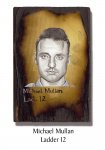
CAPT MICHAEL MULLAN USAR
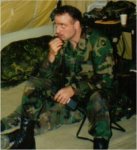
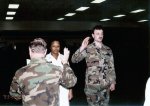
MULLAN HALL
Mullan Hall
JTF-CS headquarters was dedicated on June 14, 2012 in memory of U.S. Army Capt. Michael Dermott Mullan, who was one of the 343 New York City firefighters who died while responding to the 9-11 terrorist attacks against the World Trade Center. He was a decorated U.S. Army Reserve nurse, an emergency room nurse, and a New York City firefighter, cited for bravery. He died rescuing civilians and fellow firefighters trapped inside the adjacent Marriott Hotel to the South World Trade Center. As a first responder, Capt. Mullan was committed to saving lives while serving his country as a Citizen Soldier. That core principle is the backbone of Joint Task Force Civil Support. The dedication ceremony was attended here by more than 200 people to include his mother, Mrs. Theresa Mullan, his sister and brother, 24 New York City firefighters, local-area firefighters, a Virginia Delegate, a Congressman and others. He was remembered as a selfless, caring person; a Yankees fan; a great piano man; and a bit of a prankster who “was larger than life,” according to his fellow firefighters.
• Capt. Michael D. Mullan (Apr 6, 1967 – Sept. 11, 2001): decorated U.S. Army Reserve nurse with the 344th Combat Support Hospital, an emergency room nurse at Mercy Medical Center, and New York City firefighter with Engine 3, Ladder 12, Battalion 7.
• Capt. Mullan served honorably in the U.S. Army for 15 years and distinguished himself in service to the New York City Fire Department for seven years.
• Capt. Mullan died during the September 11, 2001 terrorist attacks in New York City while rescuing civilians and fellow firefighters trapped inside the Marriott Hotel adjacent to the North and South World Trade Center. He was one of the 343 New York City firefighters who died while responding.
• Instead of heeding an order to evacuate the hotel, Mullan instead chose to respond to a distress call from two other firefighters located several floors up. As he made his way to the stairs, the Tower Two fell, tearing away most of the face of the hotel.
• As a first responder, Capt. Mullan was committed to saving lives while serving his country as a Citizen Soldier.
• Mullan Hall is located at 1504 Madison Ave., Joint Base Langley-Eustis, Newport News, Va., and is the JTF-CS headquarters.
• The Mullan Hall dedication ceremony on June 14, 2012 was held on the 237th birthday of the U.S. Army.
• “Mike chose the military to honor his father; he chose nursing to honor his mother; and he chose firefighting to honor himself,” – Battalion Chief Thomas S. McCarthy
Theresa V. Mullan, mother of U.S. Army Reservist and New York City fire fighter Michael D. Mullan, reads the placard formally dedicating the Joint Task Force Civil Support's headquarters building for her son Michael D. Mullan, June 14, 2012
CPT Mullan was a fifteen-year US Army Reserve veteran who had enlisted as a medic, and after attending nursing school was accessed as a Nurse Corps officer. His Reserve unit was the 344th Combat Support Hospital, Ft. Totten, NY
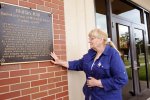
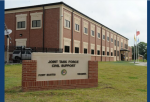
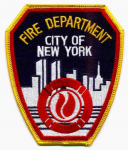
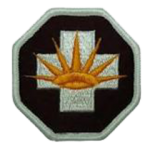
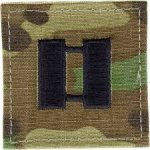
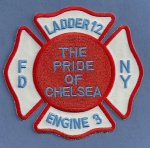
RIP. NEVER FORGET.
LADDER 12 LODD
FF MICHAEL MULLAN, LAD. 12 SEPTEMBER 11, 2001 WTC

Firefighter Michael Mullan
Ladder 12
Laid to Rest
on October 20, 2001
Firefighter Michael Mullan
Michael Dermott Mullan 'Full of Devilment,' He Lived Every Day October 5, 2001 Michael Mullan, 34, was born and reared in Flushing, where he graduated from Holy Cross High School and attended Queensboro Community College. At the time of the World Trade Center attacks, Mullan was studying for a bachelor's degree in nursing at Hunter College. He was on the 19th floor when he and other firefighters received orders to evacuate, because "the building was starting to go," according to his mother, Theresa. Mullan and two other firefighters headed down but stopped at the third floor, where they heard a Mayday call from two firefighters higher up. "Michael said, 'I'll go get them,'" his mother said - and that was the last anyone heard of him. A registered nurse, Mullan also worked in the Mercy Hospital emergency room on a per diem basis. He was a captain in the U.S. Army Reserve and worked for Ladder 12, Engine Co. 3 in Chelsea. He was "just about" engaged to his girlfriend, his mother said. She continued: "There's an old Irish expression: May you live every day of your life. Michael lived every day of his life." An avid Yankees fan, "he took it as a personal insult if they lost. He loved plays and concerts, and, oh, when he played the piano, you could not tell the difference between Michael Mullan and Jerry Lee Lewis. When he got up, the piano went into cardiac arrest. And he loved Elvis! He kept saying to me, 'Mom, you must have had a great time in the '50s.' And let me tell you, he was full of devilment and merriment and mischief." After the attack, she visited Blessed Sacrament, his grammar school, to ask for the children's prayers. "And when I walked into the principal's office, I said, 'Do you know, this is the first time I have walked into this office that I did not get sent for?'" Devilment aside, Theresa Mullan said, "Michael always made you laugh." He is also survived by his father, Patrick; brother, Patrick, and sister, Kelly-Ann Mary. "And don't forget," his mother said, "It's 'Mullan' with an 'a.'" --Mary Voboril (Newsday)
http://bravestmemorial.net/html/members/mullan_michael_fr_l012.html
Firefighter Mike Mullan of Ladder 12 was also a Captain in the Army Reserve and an R.N. who worked in the ER at Mercy Hospital, with longer term plans to become a nurse practitioner. “He played the piano like Jerry Lee Lewis,” his mother said, “and when he got up, the piano went into cardiac arrest.
http://betterangels911.com/firefighter-michael-mullan/

CAPT MICHAEL MULLAN USAR


MULLAN HALL
Mullan Hall
JTF-CS headquarters was dedicated on June 14, 2012 in memory of U.S. Army Capt. Michael Dermott Mullan, who was one of the 343 New York City firefighters who died while responding to the 9-11 terrorist attacks against the World Trade Center. He was a decorated U.S. Army Reserve nurse, an emergency room nurse, and a New York City firefighter, cited for bravery. He died rescuing civilians and fellow firefighters trapped inside the adjacent Marriott Hotel to the South World Trade Center. As a first responder, Capt. Mullan was committed to saving lives while serving his country as a Citizen Soldier. That core principle is the backbone of Joint Task Force Civil Support. The dedication ceremony was attended here by more than 200 people to include his mother, Mrs. Theresa Mullan, his sister and brother, 24 New York City firefighters, local-area firefighters, a Virginia Delegate, a Congressman and others. He was remembered as a selfless, caring person; a Yankees fan; a great piano man; and a bit of a prankster who “was larger than life,” according to his fellow firefighters.
• Capt. Michael D. Mullan (Apr 6, 1967 – Sept. 11, 2001): decorated U.S. Army Reserve nurse with the 344th Combat Support Hospital, an emergency room nurse at Mercy Medical Center, and New York City firefighter with Engine 3, Ladder 12, Battalion 7.
• Capt. Mullan served honorably in the U.S. Army for 15 years and distinguished himself in service to the New York City Fire Department for seven years.
• Capt. Mullan died during the September 11, 2001 terrorist attacks in New York City while rescuing civilians and fellow firefighters trapped inside the Marriott Hotel adjacent to the North and South World Trade Center. He was one of the 343 New York City firefighters who died while responding.
• Instead of heeding an order to evacuate the hotel, Mullan instead chose to respond to a distress call from two other firefighters located several floors up. As he made his way to the stairs, the Tower Two fell, tearing away most of the face of the hotel.
• As a first responder, Capt. Mullan was committed to saving lives while serving his country as a Citizen Soldier.
• Mullan Hall is located at 1504 Madison Ave., Joint Base Langley-Eustis, Newport News, Va., and is the JTF-CS headquarters.
• The Mullan Hall dedication ceremony on June 14, 2012 was held on the 237th birthday of the U.S. Army.
• “Mike chose the military to honor his father; he chose nursing to honor his mother; and he chose firefighting to honor himself,” – Battalion Chief Thomas S. McCarthy
Theresa V. Mullan, mother of U.S. Army Reservist and New York City fire fighter Michael D. Mullan, reads the placard formally dedicating the Joint Task Force Civil Support's headquarters building for her son Michael D. Mullan, June 14, 2012
CPT Mullan was a fifteen-year US Army Reserve veteran who had enlisted as a medic, and after attending nursing school was accessed as a Nurse Corps officer. His Reserve unit was the 344th Combat Support Hospital, Ft. Totten, NY






RIP. NEVER FORGET.
ENGINE 3/LADDER 12/HIGH RISE 1/BATTALION 7 (CONTINUED)
BATTALION 7 LODD
BC ORIO PALMER, BN. 7 SEPTEMBER 11, 2001 WTC
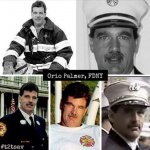

In Memoriam Sept 11
August 7, 2019 ·
Orio Joseph Palmer (March 2, 1956 – September 11, 2001) was a Battalion Chief of the New York City Fire Department who died while rescuing civilians trapped inside the World Trade Center on September 11, 2001. Palmer led the team of firefighters that reached the 78th floor of the South Tower, the floor where the plane had struck the building.
According to The 9/11 Commission Report, audio and video recordings prominently featuring Orio Palmer have played an important role in the ongoing analysis of problems with radio communications during the September 11 attacks.
Palmer graduated from Cardinal Spellman High School in The Bronx, New York in 1974. He held an associate degree in electrical technology.
According to John Norman, Palmer was very fit and ran marathon races. Historian Peter Charles Hoffer wrote that Palmer was "in superb condition".
Reporter Michael Daly wrote, "The 45-year-old Palmer was one of the department's rising stars, renowned for his smarts and nerve and decency, as well as his physical fitness." He was married to Debbie Palmer, and had three children, Dana, Keith and Alyssa. Palmer finished the New York City marathon as well as a dozen half-marathons and a couple of triathlons. Orio was also the first FDNY member to be awarded the department's physical fitness award five times.
He was said to be one of the "most knowledgeable people in the department" about radio communication in high-rise fires, and authored a training article for the department on how to use repeaters to boost radio reception during such emergencies. Palmer was also published in a number of nationally distributed firefighting magazines as well as the internal FDNY newsletter. He also taught FDNY promotional classes at night while working toward his own bachelor's degree in Fire Engineering from John Jay College.
Footage of Palmer was used in the CBS film 9/11, and later in the HBO film In Memoriam: New York City, 9/11/01. The video footage was shot by French documentary filmmakers Jules and Gedeon Naudet at the North Tower. It shows Palmer conferring with Deputy Chief Peter Hayden and Assistant Chief Donald Burns at the North Tower. The South Tower had just been hit. The men discuss how to respond to the two towers, and the communications problems they faced. The sound of a falling body hitting pavement outside reverberates. According to Michael Daly, "Palmer stood steady and calm, an air pack on his back, a red flashlight bound with black elastic to his white helmet, a radio in his left hand. His face showed only a readiness to do whatever was needed." The men decided that Burns and Palmer would proceed to the South Tower.
After arriving at the South Tower of the World Trade Center, Palmer single-handedly fixed an elevator and took it up to the 41st floor sky lobby. Once there, he went on to run up 37 flights of stairs to reach the plane’s impact zone on the 78th floor. Orio was met there by Fire Marshal Ronald Paul Bucca; they were the only first responders to reach the impact zone that day. There he reported, “Numerous 10-45s, code ones” or fatalities. Orio directed survivors of the impact how to get out of the building, relayed essential information to firemen below over the radio in an attempt to form a strategy to combat the flames and evacuate survivors, and brought comfort to those stuck and injured on the 78th floor by assuring them that help was coming.
When an audiotape of communication with the firefighters was released, it revealed that firefighters did not anticipate the building's collapse. Palmer, issuing an order to one of his subordinates, was recorded seconds before the building collapsed. Peter Charles Hoffer described Palmer's professionalism during the final moments of his life: "Listening to Palmer and his comrades on the recovered tape, one can hear the urgency of men working at high efficiency, but there was never a hint that the clock was running out on them."
Transcripts of Palmer's last broadcast were published in 2002. The actual recordings were made public in 2005, as the result of a lawsuit filed by The New York Times and families of some of the firefighters killed on September 11. Monica Gabrielle of the Skyscraper Safety Campaign commented on the release of the tapes: "Today we are one step closer to learning what happened on 9/11 in NYC — where we excelled, where we failed."
According to The Times of London, "Chief Palmer made it to the impact zone on the 78th floor of the south tower before the building collapsed. Once there the battalion chief reported 'Numerous 10–45s, Code Ones' — fire department code for dead people."
When new tapes were made public in 2006, Palmer's brother-in-law, FDNY Lt. Jim McCaffrey, stated, "It was emotional sitting with my wife and sister-in-law, listening to the tapes. You're hearing him right at that point prior to the collapse, about the things he saw on the 78th floor. Before that, we didn't even know he got higher than the 40th floor."
In 2004, The 9/11 Commission Report relied on analysis of the North Tower lobby conversations between Palmer, Peter Hayden and Donald Burns in the film shot by Jules and Gedeon Naudet to better understand what was and was not working on the fire department's communications in those critical minutes. The report stated that, "Of particular concern to the chiefs—in light of FDNY difficulties in responding to the 1993 bombing—was communications capability.
One of the chiefs recommended testing the repeater channel to see if it would work." Peter Hayden, who survived, later testified, "People watching on TV certainly had more knowledge of what was happening a hundred floors above us than we did in the lobby.... without critical information coming in... it's very difficult to make informed, critical decisions".
The 9/11 Commission carefully analyzed the FDNY radio communications that day, and reported that the battalion chief (Palmer) was able to maintain radio communication that "worked well" with the senior chief in the lobby of the South Tower during the first fifteen minutes of his ascent. A message from a World Trade Center security official that the impact was on the 78th floor was relayed to Palmer, and he decided to try to take his team to that level. Beginning at 9:21 AM, Palmer was no longer able to reach the lobby command post, but his transmissions were recorded and analyzed later. He reached the 78th floor sky lobby, and his team not far behind him were able to free a group of civilians trapped in an elevator at 9:58 AM. Palmer radioed that the area was open to the 79th floor, "well into the impact zone", and reported "numerous civilian fatalities in the area". One minute later, at 9:59 AM, the South Tower collapsed, killing everyone still inside.
Michael Daly concluded that Palmer, "an uncommonly brave fire chief who was one of the department's most knowledgeable minds in communications perished never knowing of warnings telephoned by at least two callers less than 30 stories above him."
Although they lost their lives themselves, Palmer and his crew had played an "indispensable role in ensuring calm in the stairwells, assisting the injured and guiding the evacuees on the lower floors."
After his death, the New York City Fire Department (FDNY)'s physical fitness award was renamed the Orio Palmer Memorial Fitness Award in his memory after September 11, 2001.
At the National September 11 Memorial & Museum, Palmer is memorialized at the South Pool, on Panel S-17.
In an early-morning ceremony on May 10, 2014, the long-unidentified remains of 1,115 victims were transferred from the city medical examiner's to Ground Zero, where they would be placed in a space in the bedrock 70 feet below ground, as part of the 9/11 Museum. Reaction to the move was split among the families of the 9/11 victims, with some hailing the decision, and others protesting the location as inappropriate.
Among the latter was Orio Palmer's brother-in-law, FDNY Lt. James McCaffrey, who demanded a ground-level tomb as a more dignified location. Said McCaffrey, "The decision to put the human remains of the 9/11 dead in this basement is inherently disrespectful and totally offensive." McCaffrey stated that the remains deserves a place of prominence equal to that of the Memorial's trees and pools, and opined that the ceremony was held early in the morning due to opposition to the decision.
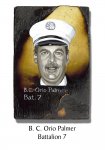
http://betterangels911.com/b-c-orio-palmer/

RIP. NEVER FORGET.
BATTALION 7 LODD
BC ORIO PALMER, BN. 7 SEPTEMBER 11, 2001 WTC


In Memoriam Sept 11
August 7, 2019 ·
Orio Joseph Palmer (March 2, 1956 – September 11, 2001) was a Battalion Chief of the New York City Fire Department who died while rescuing civilians trapped inside the World Trade Center on September 11, 2001. Palmer led the team of firefighters that reached the 78th floor of the South Tower, the floor where the plane had struck the building.
According to The 9/11 Commission Report, audio and video recordings prominently featuring Orio Palmer have played an important role in the ongoing analysis of problems with radio communications during the September 11 attacks.
Palmer graduated from Cardinal Spellman High School in The Bronx, New York in 1974. He held an associate degree in electrical technology.
According to John Norman, Palmer was very fit and ran marathon races. Historian Peter Charles Hoffer wrote that Palmer was "in superb condition".
Reporter Michael Daly wrote, "The 45-year-old Palmer was one of the department's rising stars, renowned for his smarts and nerve and decency, as well as his physical fitness." He was married to Debbie Palmer, and had three children, Dana, Keith and Alyssa. Palmer finished the New York City marathon as well as a dozen half-marathons and a couple of triathlons. Orio was also the first FDNY member to be awarded the department's physical fitness award five times.
He was said to be one of the "most knowledgeable people in the department" about radio communication in high-rise fires, and authored a training article for the department on how to use repeaters to boost radio reception during such emergencies. Palmer was also published in a number of nationally distributed firefighting magazines as well as the internal FDNY newsletter. He also taught FDNY promotional classes at night while working toward his own bachelor's degree in Fire Engineering from John Jay College.
Footage of Palmer was used in the CBS film 9/11, and later in the HBO film In Memoriam: New York City, 9/11/01. The video footage was shot by French documentary filmmakers Jules and Gedeon Naudet at the North Tower. It shows Palmer conferring with Deputy Chief Peter Hayden and Assistant Chief Donald Burns at the North Tower. The South Tower had just been hit. The men discuss how to respond to the two towers, and the communications problems they faced. The sound of a falling body hitting pavement outside reverberates. According to Michael Daly, "Palmer stood steady and calm, an air pack on his back, a red flashlight bound with black elastic to his white helmet, a radio in his left hand. His face showed only a readiness to do whatever was needed." The men decided that Burns and Palmer would proceed to the South Tower.
After arriving at the South Tower of the World Trade Center, Palmer single-handedly fixed an elevator and took it up to the 41st floor sky lobby. Once there, he went on to run up 37 flights of stairs to reach the plane’s impact zone on the 78th floor. Orio was met there by Fire Marshal Ronald Paul Bucca; they were the only first responders to reach the impact zone that day. There he reported, “Numerous 10-45s, code ones” or fatalities. Orio directed survivors of the impact how to get out of the building, relayed essential information to firemen below over the radio in an attempt to form a strategy to combat the flames and evacuate survivors, and brought comfort to those stuck and injured on the 78th floor by assuring them that help was coming.
When an audiotape of communication with the firefighters was released, it revealed that firefighters did not anticipate the building's collapse. Palmer, issuing an order to one of his subordinates, was recorded seconds before the building collapsed. Peter Charles Hoffer described Palmer's professionalism during the final moments of his life: "Listening to Palmer and his comrades on the recovered tape, one can hear the urgency of men working at high efficiency, but there was never a hint that the clock was running out on them."
Transcripts of Palmer's last broadcast were published in 2002. The actual recordings were made public in 2005, as the result of a lawsuit filed by The New York Times and families of some of the firefighters killed on September 11. Monica Gabrielle of the Skyscraper Safety Campaign commented on the release of the tapes: "Today we are one step closer to learning what happened on 9/11 in NYC — where we excelled, where we failed."
According to The Times of London, "Chief Palmer made it to the impact zone on the 78th floor of the south tower before the building collapsed. Once there the battalion chief reported 'Numerous 10–45s, Code Ones' — fire department code for dead people."
When new tapes were made public in 2006, Palmer's brother-in-law, FDNY Lt. Jim McCaffrey, stated, "It was emotional sitting with my wife and sister-in-law, listening to the tapes. You're hearing him right at that point prior to the collapse, about the things he saw on the 78th floor. Before that, we didn't even know he got higher than the 40th floor."
In 2004, The 9/11 Commission Report relied on analysis of the North Tower lobby conversations between Palmer, Peter Hayden and Donald Burns in the film shot by Jules and Gedeon Naudet to better understand what was and was not working on the fire department's communications in those critical minutes. The report stated that, "Of particular concern to the chiefs—in light of FDNY difficulties in responding to the 1993 bombing—was communications capability.
One of the chiefs recommended testing the repeater channel to see if it would work." Peter Hayden, who survived, later testified, "People watching on TV certainly had more knowledge of what was happening a hundred floors above us than we did in the lobby.... without critical information coming in... it's very difficult to make informed, critical decisions".
The 9/11 Commission carefully analyzed the FDNY radio communications that day, and reported that the battalion chief (Palmer) was able to maintain radio communication that "worked well" with the senior chief in the lobby of the South Tower during the first fifteen minutes of his ascent. A message from a World Trade Center security official that the impact was on the 78th floor was relayed to Palmer, and he decided to try to take his team to that level. Beginning at 9:21 AM, Palmer was no longer able to reach the lobby command post, but his transmissions were recorded and analyzed later. He reached the 78th floor sky lobby, and his team not far behind him were able to free a group of civilians trapped in an elevator at 9:58 AM. Palmer radioed that the area was open to the 79th floor, "well into the impact zone", and reported "numerous civilian fatalities in the area". One minute later, at 9:59 AM, the South Tower collapsed, killing everyone still inside.
Michael Daly concluded that Palmer, "an uncommonly brave fire chief who was one of the department's most knowledgeable minds in communications perished never knowing of warnings telephoned by at least two callers less than 30 stories above him."
Although they lost their lives themselves, Palmer and his crew had played an "indispensable role in ensuring calm in the stairwells, assisting the injured and guiding the evacuees on the lower floors."
After his death, the New York City Fire Department (FDNY)'s physical fitness award was renamed the Orio Palmer Memorial Fitness Award in his memory after September 11, 2001.
At the National September 11 Memorial & Museum, Palmer is memorialized at the South Pool, on Panel S-17.
In an early-morning ceremony on May 10, 2014, the long-unidentified remains of 1,115 victims were transferred from the city medical examiner's to Ground Zero, where they would be placed in a space in the bedrock 70 feet below ground, as part of the 9/11 Museum. Reaction to the move was split among the families of the 9/11 victims, with some hailing the decision, and others protesting the location as inappropriate.
Among the latter was Orio Palmer's brother-in-law, FDNY Lt. James McCaffrey, who demanded a ground-level tomb as a more dignified location. Said McCaffrey, "The decision to put the human remains of the 9/11 dead in this basement is inherently disrespectful and totally offensive." McCaffrey stated that the remains deserves a place of prominence equal to that of the Memorial's trees and pools, and opined that the ceremony was held early in the morning due to opposition to the decision.

http://betterangels911.com/b-c-orio-palmer/

RIP. NEVER FORGET.
ENGINE 3/LADDER 12/HIGH RISE 1/BATTALION 7 (CONTINUED)
ENGINE 3 WTC-RELATED DEATH
FIREFIGHTER LLOYD W STEWART ENG. 3 JULY 7, 2019
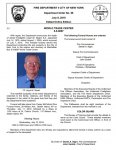

NYC Fire Wire
July 10, 2019 ·
#FDNY announces the line of duty death of retired Firefighter Lloyd W Stuart, E-3 who lost his battle with 9/11 illness.
Lloyd W. Stuart passed away on July 7, 2019 after a long battle with World Trade Center-related illness. He was born in Staten Island, and after graduating from Tottenville High School, worked for American Electric Power and Bank of Tokyo before joining the FDNY in 1970, retiring in 2005. He was a member of the National Guard, and enjoyed boating, carpentry, and spending time with his grandchildren. He is survived by his wife of 49 years, Elizabeth; daughter Denise (Daniel Bradshaw), sons William (Kelley) and Paul (Dorothy). He is also survived by his eight grandchildren; Heather and Kaitlyn Bradshaw, Leah and Noah Stuart, Bailey, Kyle and Matthew Stuart, and Brandon Dabrowski
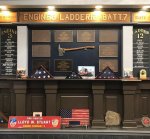
RIP. NEVER FORGET.
ENGINE 3 WTC-RELATED DEATH
FIREFIGHTER LLOYD W STEWART ENG. 3 JULY 7, 2019

NYC Fire Wire
July 10, 2019 ·
#FDNY announces the line of duty death of retired Firefighter Lloyd W Stuart, E-3 who lost his battle with 9/11 illness.
Lloyd W. Stuart passed away on July 7, 2019 after a long battle with World Trade Center-related illness. He was born in Staten Island, and after graduating from Tottenville High School, worked for American Electric Power and Bank of Tokyo before joining the FDNY in 1970, retiring in 2005. He was a member of the National Guard, and enjoyed boating, carpentry, and spending time with his grandchildren. He is survived by his wife of 49 years, Elizabeth; daughter Denise (Daniel Bradshaw), sons William (Kelley) and Paul (Dorothy). He is also survived by his eight grandchildren; Heather and Kaitlyn Bradshaw, Leah and Noah Stuart, Bailey, Kyle and Matthew Stuart, and Brandon Dabrowski

RIP. NEVER FORGET.

